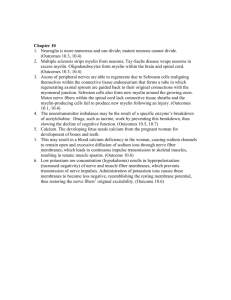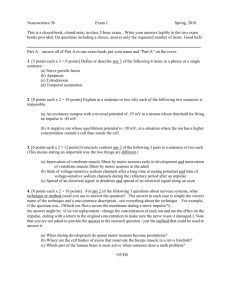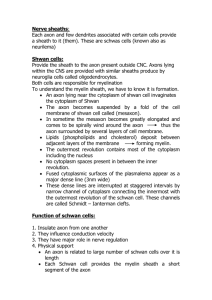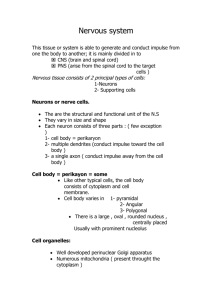Biology Muscle, Respiratory, Excretory and Immune Systems
advertisement
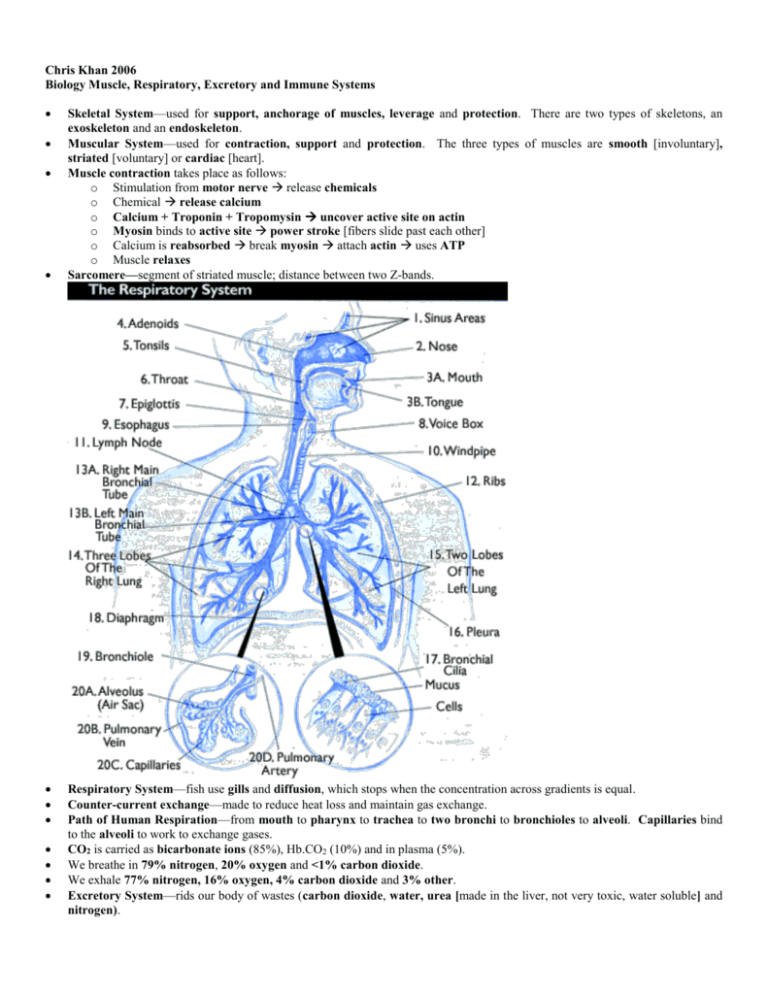
Chris Khan 2006 Biology Muscle, Respiratory, Excretory and Immune Systems Skeletal System—used for support, anchorage of muscles, leverage and protection. There are two types of skeletons, an exoskeleton and an endoskeleton. Muscular System—used for contraction, support and protection. The three types of muscles are smooth [involuntary], striated [voluntary] or cardiac [heart]. Muscle contraction takes place as follows: o Stimulation from motor nerve release chemicals o Chemical release calcium o Calcium + Troponin + Tropomysin uncover active site on actin o Myosin binds to active site power stroke [fibers slide past each other] o Calcium is reabsorbed break myosin attach actin uses ATP o Muscle relaxes Sarcomere—segment of striated muscle; distance between two Z-bands. Respiratory System—fish use gills and diffusion, which stops when the concentration across gradients is equal. Counter-current exchange—made to reduce heat loss and maintain gas exchange. Path of Human Respiration—from mouth to pharynx to trachea to two bronchi to bronchioles to alveoli. Capillaries bind to the alveoli to work to exchange gases. CO2 is carried as bicarbonate ions (85%), Hb.CO2 (10%) and in plasma (5%). We breathe in 79% nitrogen, 20% oxygen and <1% carbon dioxide. We exhale 77% nitrogen, 16% oxygen, 4% carbon dioxide and 3% other. Excretory System—rids our body of wastes (carbon dioxide, water, urea [made in the liver, not very toxic, water soluble] and nitrogen). Uric Acid is also not very toxic but insoluble. Skin—made up of the epidermis, dermis, sweat glands, pores, fat cells, etc. Dihydroxy testosterone causes hair loss by shutting down hair follicles.* Aldosterone is a steroid hormone secreted by the adrenal cortex that regulates the salt and water balance in the body. Urinary System—made up of the kidneys [function to maintain proper water and electrolyte balance, regulate acid-base concentration, and filter the blood of metabolic wastes, which are then excreted as urine], the ureter, urinary bladder, urethra, etc. Medulla—consists of renal pyramids—parts of the secreting and collecting tubules. Renal Artery—supplies blood to the kidney. Renal Vein—supplies blood back to the heart. Ureter—leads to the bladder to dispose of wastes. Glomerulus—situated within a Bowman's capsule [filter to remove organic wastes] at the end of a renal tubule in the vertebrate kidney; filters waste products. Loop of Henle—segment of nephron that is situated between the proximal and distal convoluted tubules; plays a role in the transport of ions and water and the concentrating of urine. The kidney filters out water, glucose, amino acids, salts and urea from the blood. Things that remain in the blood are blood cells, platelets, plasma, proteins, and fats. The things that are reabsorbed from the nephron include water, glucose, amino acids and salts. Then, wastes are secreted from the kidneys. High Threshold – reabsorbed into the blood. Low Threshold – not reabsorbed into the blood. Intermediate Threshold – reabsorbed or not depending on blood content. Urine includes water, urea, uric acid, salts, hormones and hemoglobin products. Immune System Organs—bone marrow, thymus [site of T cell differentiation], lymph nodes [filter bacteria and foreign particles from lymph fluid], spleen [stores blood, disintegrates old blood cells, filters foreign substances from the blood, and produces lymphocytes], tonsils and appendix. The Immune System contains antigens [stimulates the production of an antibody] and antibodies [Y-shaped protein on the surface of B cells that is secreted into the blood or lymph in response to an antigenic stimulus]. Immunity can be passive [acquired by the transfer of antibodies from another individual] or active [resulting from the development of antibodies]. 1st Line of Defense is the skin. The 2nd is the leukocytes, monocytes, and antimicrobial proteins. The 3rd is the lymphocytes [B and T] and antibodies. Cell-Mediated Response—Helper T cells activate B cells and uses cytokines. Cytotoxic [killer] T cells kill other cells. Suppressor T cells turn off immune response and Memory T cells keep a record. Humoral Response—binding to the antigen activates B Cells. Macrophages engulf antigens. Helper T Cells bind to the macrophage. B Cells are stimulated and make plasma cells, which make antibodies. * Primary Response—your reaction from a first exposure to an antigen. Secondary Response—your reaction from a second exposure to an antigen. Antibodies are made of 2 light and 2 heavy chains. Antigens are surface proteins that work as a lock and key. Clonal Selection explains how the immune system responds to infection and how certain types of B and T lymphocytes are selected for destruction of specific antigens invading the body. Nerve Cells are made of cytons, nuclei, dendrites, axons, myelin, terminal branches, and nodes of ranvier Neurons—impulse conducting cells that constitute the brain, spinal column, and nerves, consisting of a nucleated cell body with one or more dendrites and a single axon. Dendrite—an extension of a nerve cell that conducts impulses from adjacent cells inward toward the cell body. Cell Body—portion of nerve cell that contains nucleus but does not incorporate the dendrites or axon. Axon—the usually long process of a nerve fiber that generally conducts impulses away from the body of the nerve cell. Schwann Cells—any of the cells that cover the nerve fibers in the peripheral nervous system and form the myelin sheath. Nodes of Ranvier—regularly spaced gaps in the myelin sheath around an axon or nerve fiber; gaps expose the membrane of the axon to the surrounding liquid. Myelin Sheath—the fatty tissue layer coating the axon; helps speed the neural impulse by making it possible for the impulse to jump from node to node as opposed to traveling down the axon in tiny increments. Synapse—the junction across whom a nerve impulse passes from an axon terminal to a neuron, muscle cell, or gland cell. Neurotransmitters—chemical substance, such as Acetylcholine, that transmits nerve impulses across a synapse. Cholinesterase—enzyme found at nerve endings; catalyzes hydrolysis of Acetylcholine into acetic acid and choline. A Nervous System response takes place when the stimulus makes the receptor feel the action, which tells the sensory nerve, which in turn relays the message to the CNS, which interprets it and then motor neurons release effectors, which cause change [i.e. PAIN]. In a nerve, there are three stages: o Resting Stage I—before the action potential occurs, the membrane is polarized with NEGATIVE charges inside and POSITIVE charges outside. o Depolarization II—at the onset of the action potential, polarity is lost. o Repolarization III—membrane reverts back to original polarized condition due to the Sodium-Potassium Pump. HLA—group of protein molecules located on bone marrow cells that can provoke an immune response. A donor's and a recipient's HLA types should match as closely as possible to prevent the recipient's immune system from attacking the donor's marrow as a foreign material that does not belong in the body. [i.e. KIDNEY transplant] The following is not good, accurate information because I could not find detailed definitions. Antibodies do four important things: o Neutralization—to neutralize the toxins. o Agglutination—clumping of particles; usually due to an antibody or other molecule binding with multiple particles, and joining them; commonly used as a method of identifying specific bacterial antigens. o Inducing of Phagocytes—tags them with antibodies and then the macrophages engulf the foreign cells. o Activation of compliment protein—pokes hole in invader and make it explode. [Joe Cherian’s definition] This may be irrelevant to the test material.

